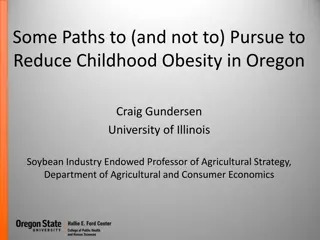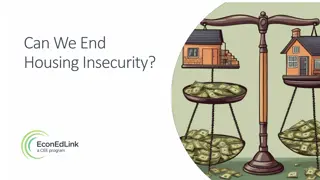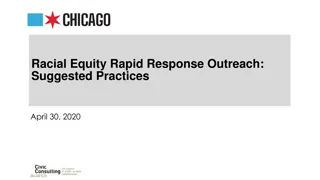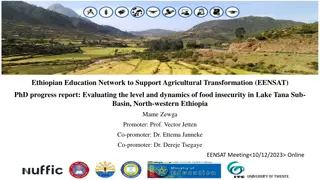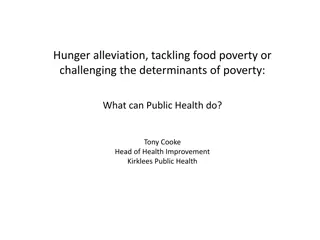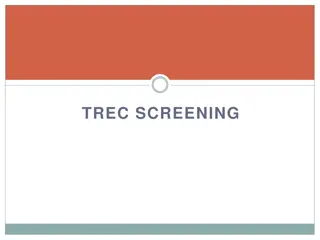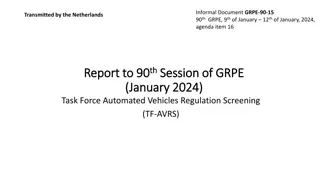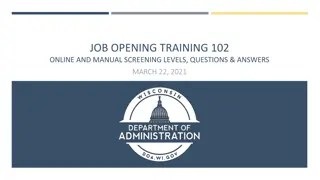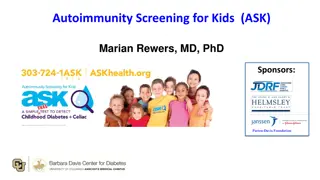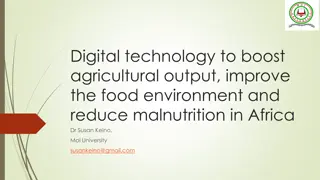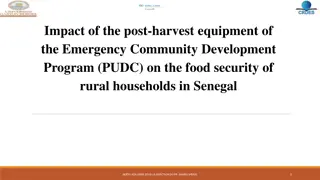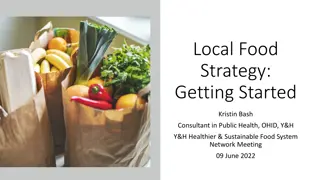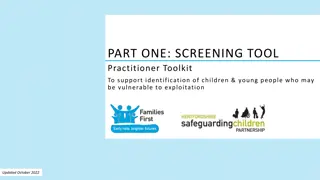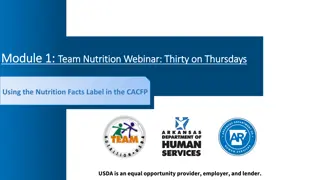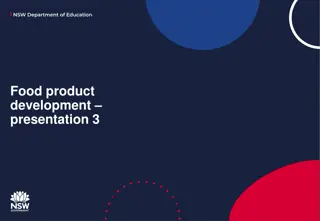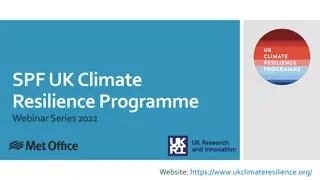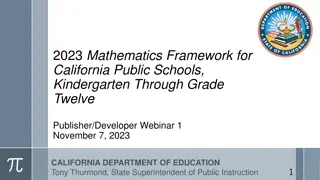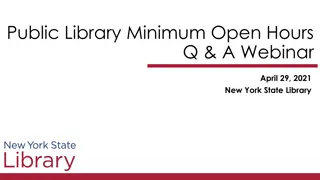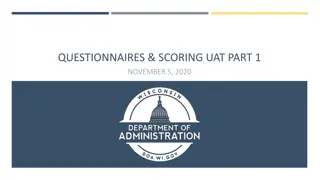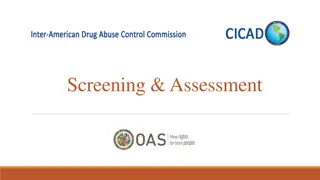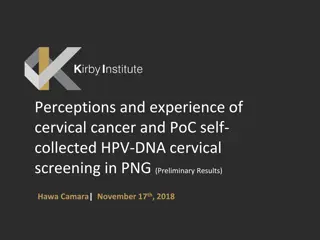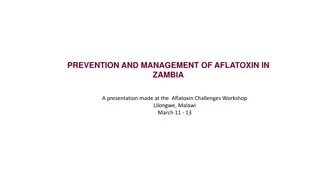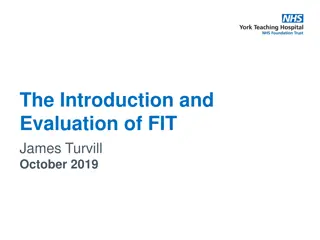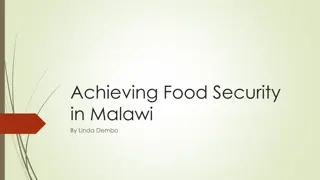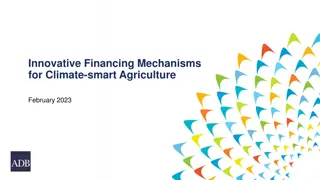Food Insecurity Education Series Webinar: Identifying and Screening Insights
Explore the significance of assessing food insecurity, different screening methods, and the impact of food insecurity on health outcomes. Understand the levels and factors influencing food insecurity, along with the importance of screening in addressing and combating this critical issue.
Download Presentation

Please find below an Image/Link to download the presentation.
The content on the website is provided AS IS for your information and personal use only. It may not be sold, licensed, or shared on other websites without obtaining consent from the author. Download presentation by click this link. If you encounter any issues during the download, it is possible that the publisher has removed the file from their server.
E N D
Presentation Transcript
Food Insecurity Education Series Webinar 3 Identifying and Screening for Food Insecurity Kathryn Tucker, MS, RD, LD, Administration for Community Living Temitope A. Walker, PhD, Georgia Division of Aging Services September 15, 2022
Objectives Define and characterize food insecurity Identify the importance of assessing food insecurity Explore the different food insecurity screens Learn about the frequency of measuring food insecurity Discover assessment training resources 2
Speakers Kathryn Tucker ACL Consultant Temitope A. Walker, PhD Senior Hunger & Nutrition Coordinator Georgia Division of Aging Services 3
What is food insecurity? Food insecurity is defined as the limited or uncertain availability of nutritionally adequate and safe foods or limited or uncertain ability to acquire acceptable foods in socially acceptable ways. 4
Levels of Food Insecurity Low food security Very low food security Poor nutrition quality and limited variety. Little or no indication of reduced food intake. Reports of skipping meals or not eating. Has reduced food availability. 5
Factors Influencing Food Insecurity Limited Income Lack of Employme nt Renting Food Insecurity Social Isolation Disparities Lack of Transporta tion Food Deserts 6
The Impact of Food Insecurity 78% more likely to experience depression 40% more likely to experience chest pain 55% more likely to develop asthma 10% more likely to experience high blood pressure 21% more likely to experience limitations in activity 7
Importance of Food Insecurity Screening Helps in Addressing Food Insecurity Supports Public Assistance Referral Program and Policy Development Program Implementation Program Evaluation Intervention Development 8
Food Insecurity Screening in Georgia Screen Identify factors Address factors 9
Measuring Food Insecurity Food insecurity is measured as a household-level concept that refers to uncertain, insufficient, or unacceptable availability, access, or utilization of food. 10
Validated Food Security Survey Modules 18-Item U.S. Household Food Security Survey Module (USDA) 10-Item U.S. Adult Food Security Survey Module (USDA) 6-item Short Form of the Household Food Security Survey Module (USDA) Hunger Vital Sign two-questionscreening tool (Children s HealthWatch) 11
18-Item U.S. Household Food Security Survey Module (USDA) Administered annually to around 45,000 households in the Census Bureau s Current Population Survey (CPS-FSS) First item addresses worries about food running out Other items address possible reductions in food intake due to finances Sample questions: Did you ever cut the size of any of the children s meals because there wasn t enough money for food? Did any of the children ever not eat for a whole day because there wasn t enough money for food? 12
10-ITEM U.S. ADULT FOOD SECURITY SURVEY MODULE (USDA) 13
Ten-Item Questionnaire Less respondent burden No children s food security questions Improves comparison of households with and without children Advantages No information about food security of children Limitations 14
USDA Six-Item Short Form Questions 1. The food that (I/we) bought didn t last and we don t have money to get more. 2. (I/We) couldn t afford to eat a balanced meal. 3. In the last 12 months, did you cut the size of your meals or skip meals because there wasn t enough money for food? 4. (If Yes) How often did this happen? 5. In the last 12 months, did you ever eat less than you felt you should because there wasn t enough money for food? 6. In the last 12 months, were you ever hungry but didn t eat because there wasn t enough money for food? 15
Six-Item Short Form Less respondent burden Identifies food insecure and very low food security High specificity and sensitivity Minimal bias Advantages Does not measure the most severe levels of food insecurity Limitations 16
Hunger Vital Sign Two-Question Food Validated Insecurity Tool Screen: 97% probability of screening positive in food insecure homes 83% probability of screening negative in food secure homes 97% sensitivity among adults and young children 74% specificity range among adults Easy to use in clinical and community settings Administered verbally or in writing Available in many languages 18
Two-Item Questionnaire Less respondent burden High specificity and sensitivity Validated for children and adults Advantages Does not measure the most severe levels of food insecurity Limitations 19
What We Do in Georgia Validated six-item food insecurity measure since 2011 Statewide statistics of clients comparable to federal statistics Identified critical unmet need for nutrition services Shows significant contribution of receiving nutrition services to achieve food security Highlights difficulty in meeting basic food and health care needs of food insecure older Georgians 20
Modified six-item U.S. Household Food Security Survey Module 6-Item food insecurity survey questions 1. During the last 30 days, how often was this statement true: The food that we bought just didn't last, and we didn't have money to get more Responses Often Sometimes Never Often Sometimes Never Yes | No 2. During the last 30 days, how often was this statement true: We couldn't afford to eat balanced meals. 3. In the past 30 days, did you or other adults in your household ever cut the size of your meals because there wasn't enough money for food? 4. In the past 30 days, did you or other adults in your household ever skip meals because there wasn't enough money for food? 5. In the last 30 days, did you ever eat less than you felt you should because there wasn't enough money to buy food? 6. In the last 30 days, were you ever hungry but didn't eat because you couldn't afford enough food? Yes | No Yes | No Yes | No 21
Quantifying Food Insecurity Using the Six-Item Survey Module Sum of affirmative responses ( Often / Sometimes and Yes ) Food insecurity summary score (score of 0-6) is calculated Individuals classified into one of four levels or two levels: Food security (score 0) Marginal food security (score 1) Low food security (score 2-4) Very low food security (score 5-6) Food secure (score of 0-1) Food insecure (score of 2-6) 22
Levels of Severity of Food Insecurity Least severe: Was this statement often, sometimes, or never true for you in the last 12 months? "We worried whether our food would run out before we got money to buy more." Somewhat more severe: Was this statement often, sometimes, or never true for you in the last 12 months? "We couldn't afford to eat balanced meals." Midrange severity: In the last 12 months, did you ever cut the size of your meals or skip meals because there wasn't enough money for food? Most severe: In the last 12 months, did you ever not eat for a whole day because there wasn't enough money for food? 23
When to Assess Food Insecurity Initial intake In conjunction with other relevant assessments When identified by concerned staff or volunteer During reassessments When services change Timepoints based on state and agency requirements 24
Potential Assessment Training Resources Review state and agency policy first; training may be available there. USDA Food Security Survey Modules are standardized and provide a straightforward process in how they should be administered. The short form of the U.S. Household Food Security Survey Module used in Georgia. See this session s takeaway sheet for additional resources from organizations such as Feeding America and the Food Research & Action Center (FRAC). 25
Takeaways Find a screen that works best for your agency Recognize that these screens should not be used alone Determine the frequency of assessment Identify participants at risk and screen them Leverage the value of assessing food insecurity Provide staff training on food insecurity and assessing it 26
Food Insecurity Webinar Series & Educational Topics July 2022: Combating Food Insecurity with Collaboration September 2022: Identifying and Screening for Food Insecurity October 2022: Referring Participants Who are Food Insecure August 2022: State Unit Food Insecurity Promising Practices Recordings available NRCNA website at acl.gov/senior-nutrition 27
For Dietitians To receive CPEU credit, go to the CDR website. Log the program: Step 2: Activity Log under Activity Type 170 - Lecture/Seminar or Activity Type 171 - Teleseminar/Webinar Claim 1 CPEU for every 1 contact hour spent during the activity. Save all documentation of the webinar and attendance for records. 28
Kathryn Tucker, MS, RD, LD, FAND: Kathryn.tucker@acl.hhs.gov Temitope Walker, Ph.D.: Temitope.walker@dhs.ga.gov QUESTIONS? 29
References Food Insecurity (Healthy People 2030) Food Insecurity and Health Outcomes (Gundersen, C. & Zilak, J.) Food Insecurity and Hunger in the United States: An Assessment of the Measure (Panel to Review the U.S. Department of Agriculture s Measurement of Food Insecurity and Hunger) Press. Food Security in the U.S. (USDA) Food Security of Older Adults Requesting Older Americans Act Nutrition Program in Georgia can be Validly Measured Using a Short Form of the U.S. Household Food Security Survey Module (Lee, J., Johnson, M., Brown, A., & Nord, M.) Nutritional and Health Consequences are Associated with Food Insecurity among U.S. Elderly Persons (Lee, J. & Frongillo, E.) The Hunger Vital Sign (Children s HealthWatch) 30


